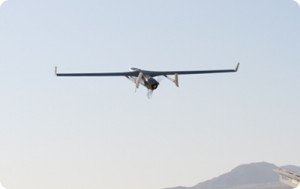Insitu Inc. has announced the first flight of the U.S. Navy and U.S. Marine Corps Small Tactical Unmanned Aircraft System (STUAS) RQ-21A UAS. The 1-hour test flight of the UAS commenced at 1538 PDT on July 28 at an Insitu facility in eastern Oregon.
“The government-industry team that achieved the successful first flight of RQ-21A is absolutely dedicated to delivering the best technology to the warfighter,” said Insitu Senior Vice President of Integrator Programs Ryan Hartman.
The first flight of the STUAS RQ-21A occurred with nearly six months remaining in a tight, 27-month Engineering, Manufacturing and Development (EMD) acquisition phase of the STUAS program. The U.S. Navy is slated to consider purchasing a low-rate initial production (LRIP) version of RQ-21A when the EMD phase ends.
“Insitu is confident that our second operational assessment at the end of this year will open the door for LRIP to begin, just as our first operational assessment opened the door for an early operational capability to begin” said Hartman. “We’re continuing to test fly RQ-21A throughout the year to ensure we give the Marines the best choice.”
“First flight of the RQ-21A marks the start of a very fast paced integrated Developmental & Operational test period, which begins at NAS China Lake later this month. The Insitu/Government team is very excited and motivated to deliver the first expeditionary, multi-intelligence UAS to the Navy and Marine Corps in this class. The organic ISR capability this UAS will provide to the Marine Air Ground Task Force (MAGTF) will be a huge enabler for our Marine Expeditionary Units (MEU) and the Navy & Marine Corps team afloat,” said PMA-263 Program Manager, Colonel James E. Rector, USMC.
Marines are currently training with RQ-21A’s precursor Integrator UAS which was assessed in early CY 2011 during the STUAS RQ-21A program’s first Operational Assessment (OA-1). Following OA-1, the Integrator UAS was delivered to the Marines in early CY 2012 as the STUAS RQ-21A program’s Early Operational Capability (EOC) system. The Integrator UAS is based on the ScanEagle UAS which moves with expeditionary forces on land and sea, logging more than 600,000 combat-flight hours since it first deployed with the Marines in 2004. ScanEagle UAS concepts drove the Integrator UAS design, and the Integrator UAS design served as the baseline for the RQ-21A UAS design.
“We look forward to delivering the STUAS capability with the same flexible hub-and-spoke concept of operations that we proved with ScanEagle,” said Hartman.
The STUAS program was awarded to Insitu for its Integrator UAS in July 2010 to provide persistent maritime and land-based tactical intelligence, surveillance and reconnaissance data collection and dissemination capabilities to the warfighter.



















